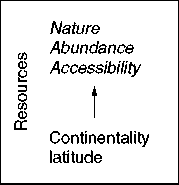Provenance studies have since the 1980s been conducted in a techno-economic perspective, and a large documentation is available on lithic transfers for the entire Palaeolithic of western Europe (WE), western central Europe (WCE), and eastern central Europe (ECE). Monitoring change versus continuity and macroregional variability for the Middle and Upper Palaeolithic allows major issues to be addressed, namely the question of behavioral/cognitive differences across the Middle/Upper Palaeolithic divide, and the degree to
Diachronic Change: Scale of Transfers
Middle Palaeolithic transfers In the European Middle Palaeolithic, MTDs greater than 100 km (65 miles) are recorded for only 11 sites (8%), all late Middle Palaeolithic, out of 145 (Figure 2), with a maximum of 300 km in three instances. On the assumption that Middle Palaeolithic transfers are correlates of group mobility, and MTDs are proxies for the maximum size of territories, the very high proportion of MTDs smaller than 100 km (n = 134, 92%) suggests that in most cases subsistence requirements were met within those bounds.
Patterns, rates and scales of movement
Scale and density
Group mobiity
Interaction networks

Figure 1 The role of ecological conditions in the development of long-term adaptive strategies.
Hunter-gatherer subsistence strategies
Environment
Distances (km)
Figure 2 Frequency distributions of MTDs recorded for European Middle Palaeolithic (MP) and Upper Palaeolithic (UP) lithic assemblages, respectively. There is a single MTD per assemblage. Data for the so-called transitional industries such as the Chatelperronian, the Bohunician, and the Szeletian, are included in the Upper Palaeolithic distribution. Data come from France and Belgium for WE, from Germany and Switzerland for WCE, from Poland, Hungary, eastern Austria, the Czeck, and Slovak Republics for ECE.
Upper Palaeolithic transfers A dramatic increase (n = 173, 49%) in the number of sites with MTDs greater than 100 km is observed for the European Upper Palaeolithic (Figure 2). The absolute threshold of the (Late) Middle Palaeolithic (300 km) is overshot, since transfers (n = 27 occurrences) between 300 and 450 km (200-300 miles) are recorded. There are also two exceptional instances of 600 and 700 km long transfers. As a result, the proportion of sites with MTDs smaller than 100 km has fallen to 51%. The increase in the magnitude of transfers suggests differences of a socioeconomic nature. These can refer to the inner organization of groups and the patterning of their mobility, when for instance anticipated long-distance seasonal moves are considered. They can also refer to complex processes involving long-distance social interaction, the latter in particular, but not exclusively, for transfers >300 km.
Diachronic Change: Techno-economic Transport Patterns
Normative Middle Palaeolithic patterns For the entire Middle Palaeolithic of western and central Europe, in areas where there is little correspondence in lithic resource availability, terrain, and topography, transport patterns show strikingly similar characteristics. As a rule, quantities decrease in relation to distance from source, and lithics are introduced onto the sites in a more and more elaborate form. In particular, transfers exceeding 20 km are tied to small quantities of end products (blanks, tools) sometimes complemented by a few reduced cores, interpreted as portable personal gear intended for use as people go along. Interestingly, exceptions where larger quantities are brought onto sites as preformed cores from further than 20 km relate to areas yielding only poor to medium quality stone, thus arguing for the existence of a selective attitude toward raw materials in the Middle Palaeolithic. However, even in such cases, the quantities involved are smaller than in the Upper Palaeolithic and the distances much shorter: recently documented examples range from 14% to 20% transported over 30-40 km. Consequently, these exceptions should not be overrated in terms of anticipated needs in large quantities of higher-grade raw materials.
Variable Upper Palaeolithic patterns Throughout western and central Europe, Upper Palaeolithic techno-economic patterns are characterized by their extreme variability, as opposed to the Middle Palaeolithic norm. Alongside the former Middle Palaeolithic pattern, which occurs unsurprisingly where high-grade local raw material is available, another pattern is observed, consisting in the transport over long distances (140-160 km to 300 km) of substantial quantities (>50% in the Gravettian) of unworked nodules or preformed cores (with or without a complement of blanks or tools). This ‘new’ pattern points explicitly to the building up of supplies, and can be identified in most cases where the poor to medium quality local raw material is not suitable for Upper Palaeolithic blade production, although admittedly the selective attitude toward raw materials fluctuates through time and seems dependant - among other factors - on the particular demands of a given culture’s lithic technology.
Macro-regional Variability
While techno-economic patterns of transport do not vary macro-regionally and exhibit similar characteristics in the whole of Europe for the Middle and Upper Palaeolithic, respectively, MTD distributions for the Middle Palaeolithic and the Upper Palaeolithic suggest an enduring clinal relationship between greater frequency of long-distance transfers and increasing continentality across the Middle/ Upper Palaeolithic divide, in keeping with the cultural ecological paradigm.
Evidence for the Middle Palaeolithic Compared with west European MTDs, those for WCE and ECE show a forward shift of frequencies toward greater distances, in particular for the first three distance classes (Figure 3). In addition, transfers greater than 200 km are better represented in ECE. Building on this and other data, a different patterning of group mobility has been suggested for ECE, functioning on a seasonal basis and involving medium (100 km) to long-distance (230-300 km) moves following natural transit routes. Interestingly, the rare west European long-distance transfers, also following natural transit routes, occur in a region of France, the Auvergne, where environmental conditions were probably as exacting as in more continental (ECE) zones.
Evidence for the Upper Palaeolithic While in the Upper Palaeolithic MTDs exceeding 300 km are recorded for WE and WCE, they are exceptionally rare (n = 2, n = 1) in comparison with ECE (n = 24) (Figure 4). Their range is also smaller since they do

Distances (km)
Figure 4 Frequency distributions of Upper Palaeolithic MTDs for WE, WCE, and ECE, respectively. There is a single MTD per lithic assemblage. Data for the so-called transitional industries such as the Chatelperronian, the Bohunician, and the Szeletian, are included in this distribution. Note that the WE distribution is biased in favor of the ]200-250] and ]250-300] distance classes by the weight of the Auvergne transfers (see Figure 5).
Not exceed 380 km in WE and 400 km in WCE, whereas in ECE distances well over 400 km are recorded (four occurrences at 420-450 km, one at 600 km, and one at 700 km). The overall magnitude of lithic transfers is therefore greater in the latter macro-region. More interestingly, MTDs shorter than 100 km are by far the most frequent in WE, suggesting that in most cases either territories or networks were smaller than in ECE. By contrast, the ECE distribution is quite balanced, and displays relatively important percentages associated with distances greater than 100 km. The frequency distribution of MTDs for WCE is partly consistent with a location halfway along a continentality gradient, insofar as percentages for the ]100-150km] and ]150-200km] distance classes are highest, implying that most territories/networks fall within this range. This suggests that although magnitudes could be similar, longer transfers were more frequent in WCE than in WE, arguably as a result of greater continentality. WE percentages for the ]200-250 km] and ]250-300 km] distance classes seem to contradict this assumption. It should however be noted that they are mainly due to transfers in the environmentally exacting Auvergne region, which account for 58% of the occurrences (17 out of 29) for these classes. They also account for 18% of the ]150-200 km] distance class. When the Auvergne transfers are disregarded (Figure 5), the ]200-250km] distance class percentages for WE and WCE are inverted (5.9% and 6.4%, respectively); they are, in addition, both lower than the percentages for ECE (17.6%). This, as well as the very low percentages associated with the longest distances (>300km), draws WCE closer to WE rather than to ECE.




 World History
World History









